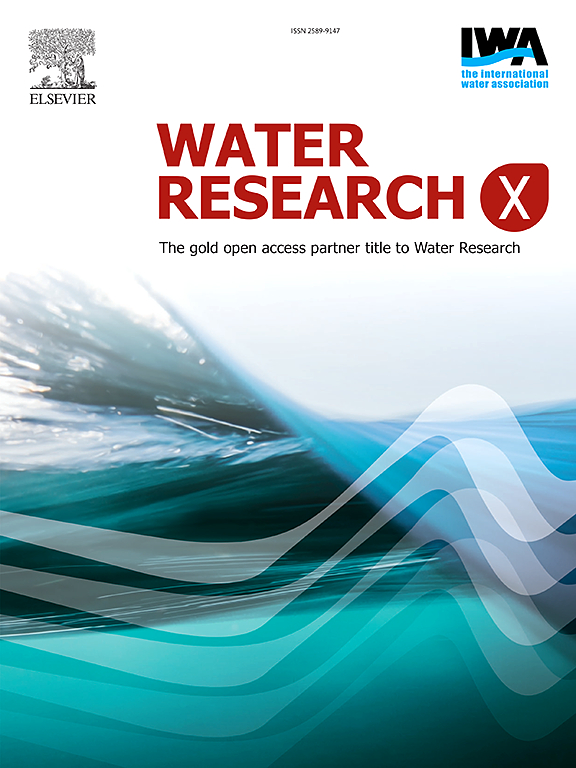Comparative enrichment of complete ammonium oxidation bacteria in floccular sludge reactors: Sequencing batch reactor vs. continuous stirred tank reactor
IF 7.2
2区 环境科学与生态学
Q1 ENGINEERING, ENVIRONMENTAL
引用次数: 0
Abstract
This study attempted to compare the enrichment of complete ammonium oxidation (comammox) bacteria, which are affiliated with Nitrospira and not able to generate nitrous oxide (N2O, a potent greenhouse gas) through biological pathways, in two commonly-utilized configurations of floccular sludge reactors, i.e., sequencing batch reactor (SBR) and continuous stirred tank reactor (CSTR), under the ammonium condition of mainstream wastewater (i.e., 40.0 g-N/m3). The results in terms of nitrification performance and microbial analyses during 216-d operation showed that compared with SBR offering a fluctuating but generally higher in-situ ammonium concentration (i.e., 1.0–6.0 g-N/m3) which was favorable for the growth of ammonium-oxidizing bacteria (AOB, belonging to Nitrosomonas in this study), CSTR managed to lower the in-situ ammonium level to < 2.0 g-N/m3, thus creating a competitive advantage for comammox bacteria with a highly oligotrophic lifestyle. Such an argument was further supported by dedicated batch tests which revealed that Nitrospira-dominant sludge had a lower maximum ammonium oxidation rate and lower apparent ammonium and oxygen affinity constants than Nitrosomonas-dominant sludge (i.e., 33.5 ± 2.1 mg-N/h/g-MLVSS vs. 139.9 ± 26.7 mg-N/h/g-MLVSS, 1.1 ± 0.1 g-N/m3 vs. 17.6 ± 4.6 g-N/m3, and 0.017 ± 0.002 g-O2/m3 vs. 0.037 ± 0.013 g-O2/m3, respectively), proving the nature of comammox bacteria as a K-strategist. Overall, this study not only provided useful insights into the effective enrichment of comammox bacteria in floccular sludge but also further revealed the interactions between comammox bacteria and AOB, thereby contributing to the future development of comammox-inclusive biological nitrogen removal technologies for sustainable wastewater treatment.

本研究试图比较在主流废水的氨氮条件(即 40.0 g-N/m3)下,两种常用的絮状污泥反应器配置(即序批式反应器(SBR)和连续搅拌池反应器(CSTR))中完全氨氧化(comammox)菌的富集情况。216 天运行期间的硝化性能和微生物分析结果表明,SBR 的原位氨浓度(即 1.0-6.0 g-N/m3)虽有波动,但总体较高,有利于氨氧化细菌(AOB,本研究中属于亚硝化单胞菌)的生长,相比之下,CSTR 能够将原位氨浓度降至 2.0 g-N/m3,从而为具有高度寡营养生活方式的兼氧细菌创造了竞争优势。专门的分批测试进一步支持了这一论点,测试结果表明,与亚硝单胞菌为主的污泥相比,亚硝螺杆菌为主的污泥的最大氨氧化率较低,表观氨和氧亲和常数也较低(即:33.5 ± 2.1 mg/m3)、33.5 ± 2.1 mg-N/h/g-MLVSS vs. 139.9 ± 26.7 mg-N/h/g-MLVSS,1.1 ± 0.1 g-N/m3 vs. 17.6 ± 4.6 g-N/m3,以及 0.017 ± 0.002 g-O2/m3 vs. 0.037 ± 0.013 g-O2/m3),证明了兼氧菌作为钾策略菌的性质。总之,这项研究不仅为有效富集絮状污泥中的兼氧菌提供了有益的启示,而且进一步揭示了兼氧菌与 AOB 之间的相互作用,从而有助于未来开发兼氧生物脱氮技术,实现污水的可持续处理。
本文章由计算机程序翻译,如有差异,请以英文原文为准。
求助全文
约1分钟内获得全文
求助全文
来源期刊

Water Research X
Environmental Science-Water Science and Technology
CiteScore
12.30
自引率
1.30%
发文量
19
期刊介绍:
Water Research X is a sister journal of Water Research, which follows a Gold Open Access model. It focuses on publishing concise, letter-style research papers, visionary perspectives and editorials, as well as mini-reviews on emerging topics. The Journal invites contributions from researchers worldwide on various aspects of the science and technology related to the human impact on the water cycle, water quality, and its global management.
 求助内容:
求助内容: 应助结果提醒方式:
应助结果提醒方式:


